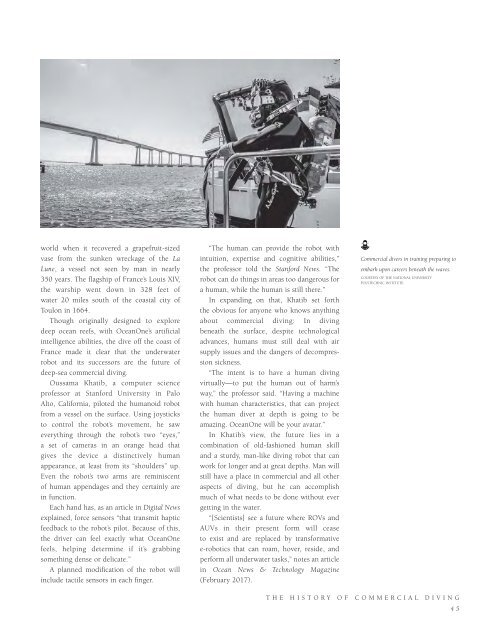Working Underwater: The Story of the Commercial Diving Industry
An illustrated history of the commercial diving industry paired with the histories of companies that have helped shape the industry.
An illustrated history of the commercial diving industry paired with the histories of companies that have helped shape the industry.
Create successful ePaper yourself
Turn your PDF publications into a flip-book with our unique Google optimized e-Paper software.
world when it recovered a grapefruit-sized<br />
vase from <strong>the</strong> sunken wreckage <strong>of</strong> <strong>the</strong> La<br />
Lune, a vessel not seen by man in nearly<br />
350 years. <strong>The</strong> flagship <strong>of</strong> France’s Louis XIV,<br />
<strong>the</strong> warship went down in 328 feet <strong>of</strong><br />
water 20 miles south <strong>of</strong> <strong>the</strong> coastal city <strong>of</strong><br />
Toulon in 1664.<br />
Though originally designed to explore<br />
deep ocean reefs, with OceanOne’s artificial<br />
intelligence abilities, <strong>the</strong> dive <strong>of</strong>f <strong>the</strong> coast <strong>of</strong><br />
France made it clear that <strong>the</strong> underwater<br />
robot and its successors are <strong>the</strong> future <strong>of</strong><br />
deep-sea commercial diving.<br />
Oussama Khatib, a computer science<br />
pr<strong>of</strong>essor at Stanford University in Palo<br />
Alto, California, piloted <strong>the</strong> humanoid robot<br />
from a vessel on <strong>the</strong> surface. Using joysticks<br />
to control <strong>the</strong> robot’s movement, he saw<br />
everything through <strong>the</strong> robot’s two “eyes,”<br />
a set <strong>of</strong> cameras in an orange head that<br />
gives <strong>the</strong> device a distinctively human<br />
appearance, at least from its “shoulders” up.<br />
Even <strong>the</strong> robot’s two arms are reminiscent<br />
<strong>of</strong> human appendages and <strong>the</strong>y certainly are<br />
in function.<br />
Each hand has, as an article in Digital News<br />
explained, force sensors “that transmit haptic<br />
feedback to <strong>the</strong> robot’s pilot. Because <strong>of</strong> this,<br />
<strong>the</strong> driver can feel exactly what OceanOne<br />
feels, helping determine if it’s grabbing<br />
something dense or delicate.”<br />
A planned modification <strong>of</strong> <strong>the</strong> robot will<br />
include tactile sensors in each finger.<br />
“<strong>The</strong> human can provide <strong>the</strong> robot with<br />
intuition, expertise and cognitive abilities,”<br />
<strong>the</strong> pr<strong>of</strong>essor told <strong>the</strong> Stanford News. “<strong>The</strong><br />
robot can do things in areas too dangerous for<br />
a human, while <strong>the</strong> human is still <strong>the</strong>re.”<br />
In expanding on that, Khatib set forth<br />
<strong>the</strong> obvious for anyone who knows anything<br />
about commercial diving: In diving<br />
beneath <strong>the</strong> surface, despite technological<br />
advances, humans must still deal with air<br />
supply issues and <strong>the</strong> dangers <strong>of</strong> decompression<br />
sickness.<br />
“<strong>The</strong> intent is to have a human diving<br />
virtually—to put <strong>the</strong> human out <strong>of</strong> harm’s<br />
way,” <strong>the</strong> pr<strong>of</strong>essor said. “Having a machine<br />
with human characteristics, that can project<br />
<strong>the</strong> human diver at depth is going to be<br />
amazing. OceanOne will be your avatar.”<br />
In Khatib’s view, <strong>the</strong> future lies in a<br />
combination <strong>of</strong> old-fashioned human skill<br />
and a sturdy, man-like diving robot that can<br />
work for longer and at great depths. Man will<br />
still have a place in commercial and all o<strong>the</strong>r<br />
aspects <strong>of</strong> diving, but he can accomplish<br />
much <strong>of</strong> what needs to be done without ever<br />
getting in <strong>the</strong> water.<br />
“[Scientists] see a future where ROVs and<br />
AUVs in <strong>the</strong>ir present form will cease<br />
to exist and are replaced by transformative<br />
e-robotics that can roam, hover, reside, and<br />
perform all underwater tasks,” notes an article<br />
in Ocean News & Technology Magazine<br />
(February 2017).<br />
<strong>Commercial</strong> divers in training preparing to<br />
embark upon careers beneath <strong>the</strong> waves.<br />
COURTESY OF THE NATIONAL UNIVERSITY<br />
POLYTECHNIC INSTITUTE.<br />
THE HISTORY OF COMMERCIAL DIVING<br />
45
















